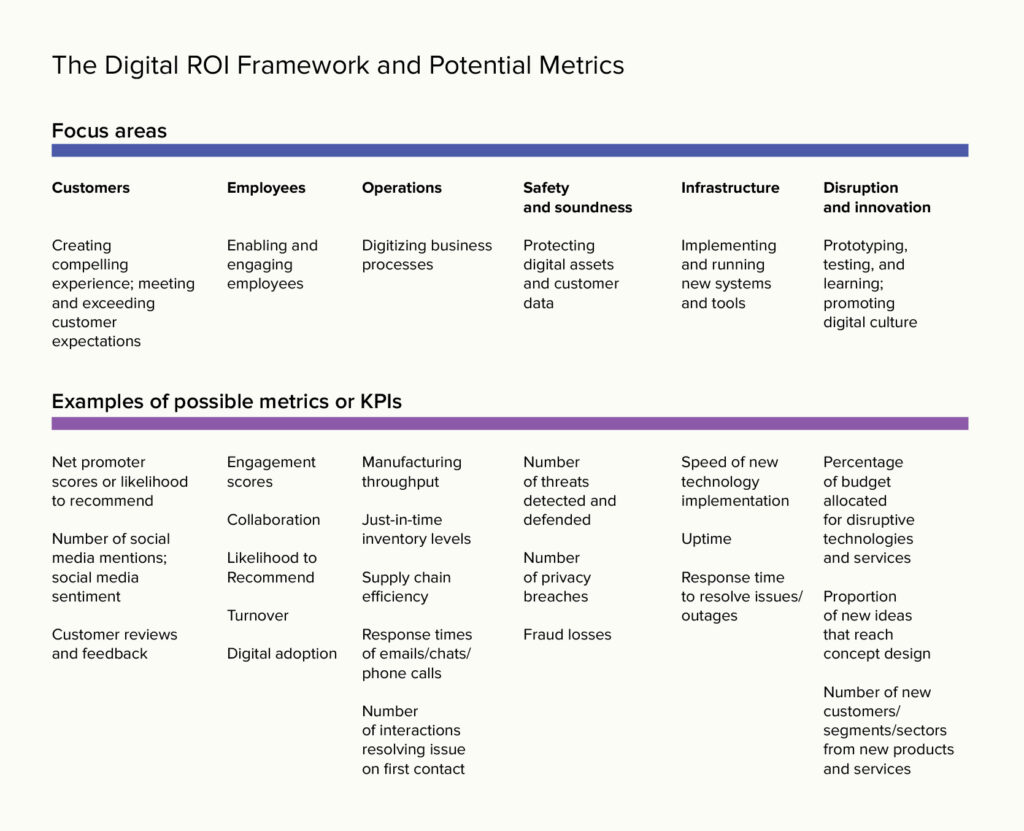Digital transformation revolutionizes business operations – it enhances productivity, streamlines processes, and delivers superior customer value. No wonder about 90% of all organizations are going through digital transformation, as McKinsey states. Yet, many executives face a critical challenge: How can they calculate the ROI?
Understanding the return on investment is essential to validate your digital transformation initiatives. This article will break it down for you. We'll outline actionable strategies, from establishing measurable objectives to analyzing metrics and consulting industry experts, helping you assess returns effectively.
Whether you're beginning your digital transformation journey or seeking to optimize existing approaches, this guide will maximize the impact of your initiatives. Let's explore the specifics and learn how to realize your organization's potential!
What is Digital Transformation ROI?
Before proceeding to the digital transformation ROI, let’s briefly define digital transformation. In simple terms, it means integrating digital technology into every part of the business, reshaping how the company works, and delivering value to customers. Now that we have the basics, we can move on to the ROI.
Digital transformation ROI represents the quantifiable benefits your organization receives from its digital initiatives. This covers reduced operational costs and enhanced operational performance. Demonstrating clear returns helps validate that your digital investments deliver tangible business value.
However, there's a significant hurdle – around 75% of executives report that accurately measuring the impact of digital transformation remains their primary challenge. Success requires a deep understanding of how these initiatives benefit operations.
Consider how robotic process automation (RPA) reduces manual workload through task automation. Similarly, cloud migration enables advanced functionality while decreasing hardware expenses.
By effectively calculating ROI, you can better communicate the impact of digital projects to executives and key stakeholders. The focus extends beyond pure metrics – it’s demonstrating how digital transformation delivers concrete business outcomes.
How to Calculate ROI for Digital Transformation
In today's technology-driven landscape, modernizing your organization is essential. However, recognizing the benefits of such evolution requires quantifying outcomes. This roadmap explains how to assess digital transformation ROI, ensuring each initiative delivers verifiable results.
Step 1: Define a Specific Digital Transformation Objective
Select a single, critical digital transformation objective for a specific timeframe. This objective should benefit the organization broadly and enable strategic resource deployment. Selecting one primary goal allows for focused strategy development and precise implementation.
Consider Company B facing peak-season demand spikes – optimizing warehouse efficiency might be more crucial than upgrading customer service platforms. Company B can enhance order fulfillment and operational excellence by prioritizing warehouse operations.
After objective selection, establish a corresponding ROI benchmark. The company might deploy warehouse automation software to reduce picking times and improve space utilization in this scenario. The ROI target would assess how effectively the software delivers these intended benefits.
Step 2: Evaluate Current Cost Dynamics
Subsequently, examine existing cost patterns to identify areas of efficiency and waste. Consider:
- Which processes deliver cost benefits?
- What inefficiencies generate excess costs?
- Which areas require investment adjustments?
If Company B opts for warehouse management technology, management must consider direct software costs and indirect expenses like staff training and system integration. This detailed cost analysis ensures alignment with transformation objectives.
Step 3: Implement Robust ROI Measurement Metrics
Digital transformation success requires targeted measurement criteria. According to PwC's digital ROI framework, evaluate six crucial domains:
- Customers
- Employees
- Operations
- Safety and Soundness
- Infrastructure
- Disruption and Innovation
Choose metrics aligned with your objective. Consider order processing speed, storage optimization rates, and fulfillment accuracy for warehouse efficiency. You can see the examples of possible metrics in the picture below.

Step 4: Establish ROI Assessment Timeframes
Create specific intervals for ROI evaluation. These may correspond with project phases or follow monthly, quarterly, or biannual schedules.
For instance, Company B might measure order processing efficiency improvements shortly after implementation. However, evaluating overall operational efficiency might require extended observation periods.
Step 5: Monitor ROI Progress and Modify Approaches
ROI measurement requires ongoing attention. Tracking results across periods reveals the true impact of digital initiatives.
Since digital transformation occurs gradually, immediate results aren't always achievable. Regular ROI assessments based on predetermined schedules help identify patterns and optimize strategies.
For example, if warehouse automation software initially underperforms, the organization can investigate challenges, implement corrections, and refine its approach to achieve objectives better.
Organizations can sustain effective and valuable digital transformation initiatives by focusing on continuous enhancement.
Key Digital Transformation Metrics
Measuring digital transformation success starts with the right metrics. Learn how data, customer experience, and adoption rates can show your progress.
Data Governance
According to Salesforce, data governance is the top metric for measuring the success of digital transformation. As companies invest more in digital transformation, managing their growing digital footprints becomes a bigger challenge.
Achieving key transformation goals becomes difficult without effective data governance, and new problems can arise. For example, poor governance in the cloud can lead to costly issues, as we highlighted in a recent post.
You can measure the success of data governance by tracking:
- Policy adherence: Strong governance requires clear rules for how data is used and who has access. You can measure compliance by checking if departments follow guidelines and if access controls are working as intended.
- Data quality: Track key data against three dimensions – completeness, accuracy, and timeliness. Regular monitoring ensures your transformation efforts continue to deliver value.
- Risk events: These include fines, penalties, or decisions based on flawed data. After implementing governance policies, the number of risk events should decrease. If not, it’s a sign to investigate where the system is failing.
Customer Experience
Studies indicate that 86% of customers are prepared to spend more for superior customer service. You should reconsider your strategy if your digital transformation programs aren't improving this aspect. Conducting a comparative analysis before and after implementation is vital to understand how your initiatives affect customer satisfaction.
Consider chatbot deployment as an illustration – while it may improve service delivery, measuring its effectiveness is vital. Use user surveys, interaction data, or participation metrics to determine whether users embrace the new technology positively.
Essential indicators for measuring digital transformation's impact on customer experience include:
- Customer Satisfaction (CSAT): Measures how content customers are with your offerings. Collect data through questionnaires or direct conversations and examine responses to determine satisfaction trends.
- Customer Effort Score (CES): Measures how much work customers must do to accomplish their goals, scored from 0 (minimal effort) to 10 (maximum effort). Better experiences yield lower scores.
- Net Promoter Score (NPS): Assesses customer likelihood to endorse your company. Request ratings from 0 to 10, grouping results as promoters (9-10), passives (7-8), or detractors (0-6).
Adoption & Performance Metrics
Usage and effectiveness indicators reveal crucial data about how team members or customers interact with designated systems or applications. Essential measurements include:
- Daily/monthly active users: Records the number of individuals utilizing a solution or service each day or month.
- Adoption rate: Calculates the ratio of current users versus potential total users.
- Duration of engagement: Shows the typical period users interact with a product or capability.
- Retention: Represents the proportion of users who engage with a product or service over time.
These measurements demonstrate how well your audience or workforce embraces new applications, systems, or capabilities. Suboptimal usage or effectiveness numbers might indicate users face challenges with your solution. This could highlight requirements for product modifications or enhanced training to boost participation and drive digital advancement initiatives.
Financial Performance
Monitoring financial metrics enables organizations to assess digital transformation's impact on profitability and determine future technology investments. Below are essential financial measurements for evaluating progress:
- Revenue growth: Digital transformation drives revenue through expanded market presence, enhanced customer interactions, and operational improvements. By tracking revenue growth, organizations can assess their digital strategy's effectiveness and implement necessary changes.
- Cost savings: Implementing digital technologies reduces expenses across IT operations, supply chain processes, and automated workflows. Measuring these reductions demonstrates financial advantages and identifies areas for additional cost optimization.
- Return on Investment (ROI): ROI evaluates financial returns from digital spending. This calculation reveals the profitability of transformation initiatives, enabling organizations to prioritize future investment decisions.
- Customer Lifetime Value (CLV): CLV represents a customer's total contribution throughout their relationship, encompassing initial sales, additional purchases, complementary products, and recommendations. Simple CLV calculations multiply average customer worth by relationship duration. More detailed analysis incorporates historical metrics like buying patterns and attrition rates using statistical approaches to estimate future returns.
- Customer Acquisition Cost (CAC): CAC calculates new customer onboarding expenses, including promotional, advertising, and sales costs. Digital transformation reduces CAC through optimized processes and enhanced efficiency, improving ROI.
Conclusion
Measuring the ROI of digital transformation is key to showing its value and ensuring it aligns with business goals. Companies can see what works and make improvements by setting clear objectives, analyzing costs, choosing the right metrics, and tracking results over time.
Beyond ROI, tracking metrics like data governance, customer experience, and adoption rates give a complete picture of progress. Strong data governance ensures reliable information, better customer experiences improve satisfaction and loyalty, and adoption metrics reveal how well new tools are being used.
Digital transformation isn’t a one-time task but an ongoing effort. By staying flexible, regularly checking results, and improving where needed, companies can maximize their investments and create lasting success.




